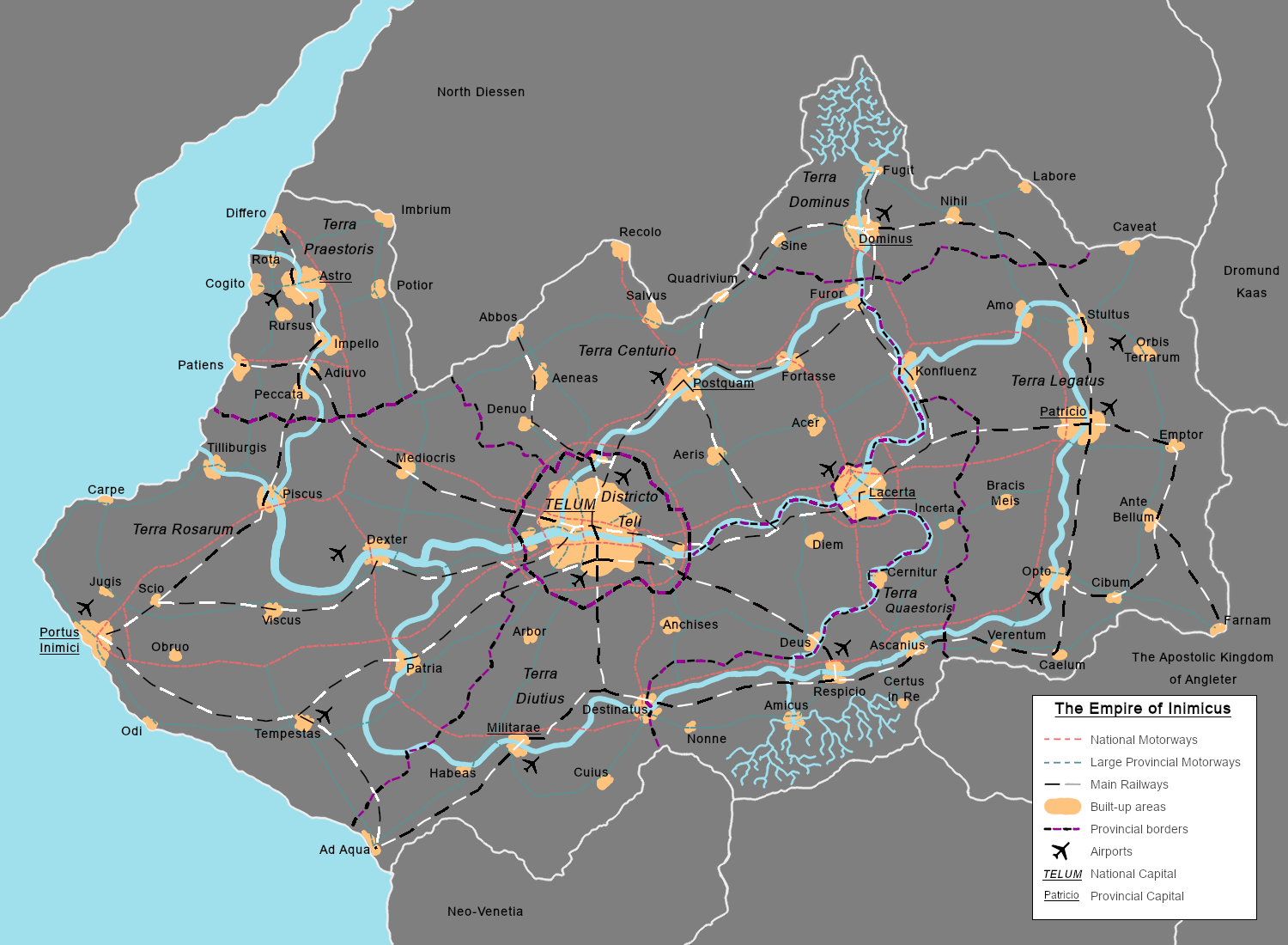Inimicus, the Empire of
-
The Empire of Inimicus

National Factbook
Statehood
- Full name: The Empire of Inimicus
- Short name: Inimicus
- Denonyms: Inimician, Inimicians
- Capital city: Telum
- Founding documents: Constitution of Inimicus
- Imperial Anthem: Heil Dir Im Siegerkranz (Hail to thee in victor's crown)
- Civil Anthem: Inveniam Viam Aut Faciam (I shall find a way, or make one)
- Official Mottos: Imperial Motto: "Oderint dum Metuant" (Let them hate, as long as they fear)
- Civilian Motto: "Αδω σωφρονών ουσωφροσιν" (Atho sophronohn ousophrosin) (I speak wisely to the unwise)
- National Holidays: September 30th (State of the Empire Day); February 19th (Imperial Birthday)
- Formed: 1351 (basic roots); 1578 (current territory encompassed); 1801 (monarchy abolished); 2012 (Empire formed)
- Head of State/Government: His Imperial Majesty Emperor Artabanos
National Executive
The National Executive consists of the Imperial Executive, appointed by the Emperor, and the Common Executive, chosen by the House of Commons.The Imperial Executive consists of:
- Imperial Consul Lord Christopher Strathclyde IC
- Imperial Consul: Simge Galanth IC
- Chancellor of the Treasury Karen Smith
- Imperial Defence Officer James Cocx IC
- Imperial Foreign Officer Sarah Caldwell IC
(IC stands for Imperial Councillor, i.e. members of the National Imperial Council)
The Common Executive consists of:
- People's Tribune Lord Michael Dowding
- People's Tribune Lynda Cocx
- People’s Tribune Nicole Iagara
- People’s Tribune Robin Sluys
- People’s Tribune Sir William Philips
- Quaestor Liliane Plumbers
- Quaestor Francis Laros
- Aedile Peter Strathclyde
- Aedile Dale Cole
Geography
- Region: European Union
- Location: Southeastern Europe
- Climate: largely temperate, mountainous climate in areas high above sea level
- Natural resources: uranium, copper, bauxite, coal, natural gas, timber, fish
Demography
- Population: 56,990,020 (03/07/2020 census)
- Urbanisation: 72%
- Denonym: Inimician
Economy (Current as of 3/7/2020)
- GDP = Ƒ 1,319,068,944,772.28
- GDP per capita = Ƒ 23,145.61
Currency
Like the Euro and most other currencies in the region, the Inimician Guilder (Inimician/German: Gulden) is a decimal coin. It evolved throughout history from a certain weight of gold (Gulden = golden) to a standardised coinage in the fifteenth century. The Guilder fluctuates between values of €1.50 and €2.00.Currency details:
Penning (₽) (I.: Penning; G.: Pfennung)
Guilder of 100 Pennings (Ƒ) (I./G.: Gulden)History
The history of Inimicus can be roughly divided into four eras:- 1351 - 1578 AD, from the founding of the earliest state in the territory of modern-day Inimicus to a major expansion project westwards doubling Inimicus's territory;
- 1578 - 1801, from the westwards expansion to the overthrow of the Kingdom of Inimicus by republican rebels;
- 1801 - 2012, from the republican revolution to the founding of the Empire of Inimicus;
- 2012 - 2013 Williamite Imperial Era;
- 2013 - 2014: Hughite Imperial Era;
- 2014 - present: Artabanite Imperial Era
Subdivision: the period 2016-2020 is often termed the Great Peace
A full history of Inimicus is currently being compiled.
-
Inimician Politics
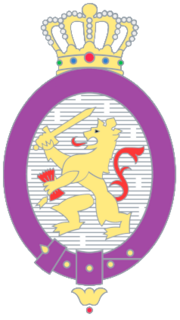
Government crest shared across official national-level departments
Politics in the Empire of Inimicus take place in the framework of a Federal Mixed-Constitutional Elective Monarchy, with the elected Emperor as the head of a powerful executive branch. Inimicus's federal traditions and Constitution grant extensive liberties to its seven Territories (also known as Terras or Provinces), including prerogatives over taxation, issuing of licences, and law enforcement. National-level political power is shared by the monarch, National Imperial Council, and Imperial Diet.
Executive power is exercised by the Emperor, elected for a life term, and officers of the National Executive. The latter comprises the Imperial Executive (appointed by the Emperor) and Common Executive (indirectly elected by popular representatives). Members of the executive branch are accountable to respective bodies of the legislature: the Emperor declares His or Her Decrees to the House of Nobles (150 appointed members), the Imperial Executive is scrutinised by the National Imperial Council (22 part-elected, part-appointed councillors), and the Common Executive is both elected and overseen by the House of Commons (750 directly elected MPs).
The Judicial branch is almost completely independent from the executive and legislature, and consists of the Imperial Crown Court, the highest court for criminal cases, the Imperial High Tribunal (for civil cases), and Territorial and District Courts at local levels.
Elections in the Empire of Inimicus
Inimicus is a democratic nation: Inimician nationals aged over 17 elect the following bodies:
- Provincial Assemblies: legislative authorities on a provincial level. Assemblies are elected on a Mixed-Member Proportional basis, allowing for direct local representation as well as proportional fairness.
- House of Commons: lower house of parliament that meets every June for 30 days. The Commons are elected using a first-past-the-post system.
- National Imperial Council: supreme legislative body representing all provinces individually. Territories are free to set their own electoral system for the choosing of their two Imperial Councillors.
- The Emperor: the highest, unchallenged authority in Inimicus, elected by Alternative Vote for life, with absolute (yet constitution-bound) prerogative; the Emperor is also Commander-In-Chief of the Armed Forces.
Note: prior to Constitutional amendments passed in 2020, Inimician suffrage included EU citizens with more than three years' residence in the Empire, and the direct election of Provincial Dukes (now frequently known as Emperor's Commissioners).
Structure of the Imperial Inimician State
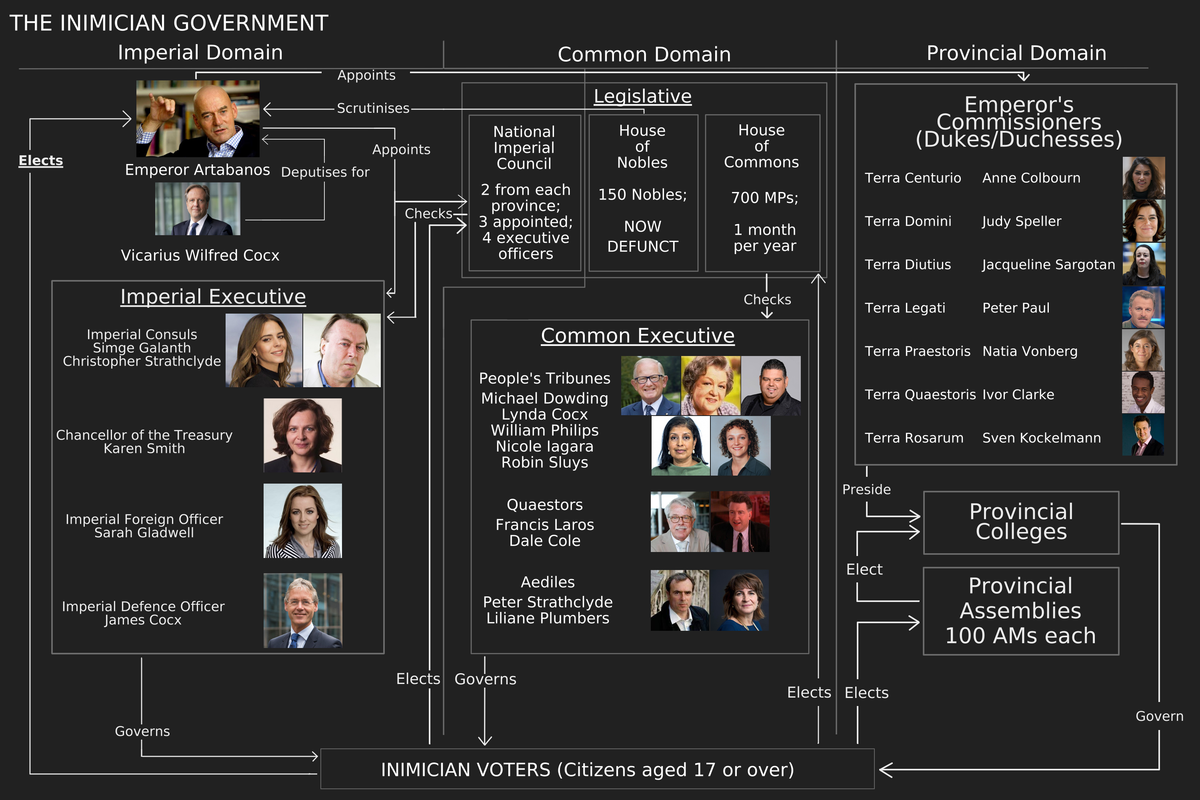
Imperial State Terminology
The following list is meant as a non-exhaustive reference for common terminology used in the framework of Inimician politics.
(Incomplete as of 6/3/2022)
- Act of Imperial Diet: legislation passed by the House of Commons
- Act of National Imperial Council: legislation passed by the National Imperial Council
- Emperor's (or Imperial) Prerogative: the set of near-absolute powers the Inimician Constitution awards to the elected monarch.
- Imperial Great Seal: term used to descibe Imperial Assent of official documents, appointments, or Acts of Imperial Diet/Council. Stems from the use of a wax seal to certify documents.
-
The Emperor of Inimicus
Motto: Oderint Dum Metuant (Let them hate, as long as they fear)

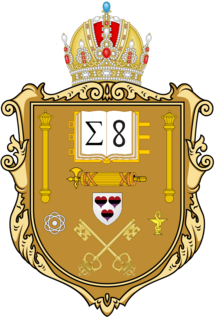
Imperial Standard and Coat of Arms

--
The Emperor (or Empress) is the legal absolute monarch of Inimicus. The Constitution of Inimicus summarises the fundamentals of the Inimician system of monarchy in its seventheenth article:
Article XVII: Imperial Fundamentals
- The Imperial prerogative shall be absolute, albeit bound to the Constitution.
- The title to the Throne shall be obtained by popular vote.
- Constitutional amendments may be enacted pursuant to Imperial Decree and a majority of the National Imperial Council.
By Constitution, the Emperor has the right to disband and raise executive offices, dissolve and call bodies of the Imperial Diet, and issue Imperial Decrees which may overrule any decision made by the Executive or Diet. However, He may not amend the Constitution without the approval of the National Imperial Council. Despite His absolute prerogative, the Emperor is expected to act as the custodian of the rights and privileges of the Inimician people, including freedom of speech and thought, free press, democratic accountability, well-being, and protection from foreign and domestic threats.
In formal correspondence and publications, personal pronouns referring to the Emperor are almost always capitalised. This is due to the supposedly divine status of Inimician monarchs in the late middle ages and early modern times. The formal state religion of Inimicus still remains the Imperial Cult surrounding divinity of monarchs. However, in practice, Inimicus is one of the most secular and atheist states in the region.
Uniquely, the office of Emperor in Inimicus is not hereditary. Emperors are elected by popular vote using the Alternative Vote system after the abdication or death of the previous incumbent. Abdication may occur if the monarch is deemed not fit for role and contracts the abdication with a healthy mind; when the Emperor contracts a marriage without the consent of the National Imperial Council; or when the Emperor voluntarily relinquishes the Imperial Prerogative for personal reasons.
The office of Emperor was created after the overthrow of the Republic of Telum in 2011. This Republic had turned into a de facto dictatorship and a small revolt in the northwest of the country evolved into a full-scale civil war. This conflict was won by the Teluminan Monarchist Party, which advocated restoration of the Inimician monarchy. Because of the federal system Inimicus had changed into over 200 Republican years, the title 'Emperor' was chosen to symbolise the unity of the new Inimician state. A new constitution was drafted and agreed upon by a large number of assemblies: each Inimician municipality held a general council, inviting any interested citizen, which each had to ratify the document and delegate two members to a National General Convention in Telum, which debated and amended the wording of the new Constitution before ultimately ratifying it and organising the first democratic elections in over two centuries.
The current incumbent Emperor is Artabanos of Inimicus. He was elected to the office on May 22nd 2014, and was crowned Emperor Artabanos of Inimicus on May 30th. Since his accession, the Empire of Inimicus has grown into a regional economic and military power, has stabilised dramatically following the turbulence of the William and Hugh eras, and was finally accepted by the international community as an equal partner. These developments were achieved by a large number of Imperial Decrees from Artabanos, and this rigorous usage of Imperial powers led to popular and Parliamentary demands for re-election. In September 2014 Emperor Artabanos called for a second, confirmatory ballot, in which He was re-elected with an even bigger popular mandate; and three years later, in summer 2017, a third national vote once again confirmed the Emperor's popularity.
Emperor Artabanos's full title is as follows:
ARTABANOS: Centuriorum, Legatorum, Quaestoriorum, Imperatorum, Rosarorum, Praestoriorum, Diutiorum Imperator Maximus; Dominus Noster, Βασιλεύς Πολεμιων, Αύτοκράτορ Πρώτος; Pontifex Maximus Religio Inimiciis; Dux Districti Teli; Caesar Legioni Inimici; Crux Maximus Ordinem Imperatoris; Dominus Ordene Supremus Nicolesii; LAUDATE!
Translated as:
ARTABANOS: of the Centurians, Legatians, Quaestorians, Imperatorians, Rosarians, Praestorians, and Diutians Supreme Emperor; Our Lord, Ruler of all Inimicians, Supreme Autocrat; Defender of the Inimician Faith; Duke of the District of Telum; Commander of the Inimician Armed Forces; Grand Cross in the Imperial Order of Inimicus; Lord of the Supreme Ordene of Icholasen; PRAISE!
-
Vicarius
Motto: Oro Supplex Et Acclinis (I kneel with a submissive heart)

The Emperor's formal deputy and second-in-command is called the Vicarius, a position currently filled by political veteran Wilfred Cocx. Although not a constitutionally established position, the Vicarius has grown into an essential role under the current political system. The Inimician Constitution specifies that the National Imperial Council shall have the power to appoint regents and manage the exercise of the Imperial Prerogative, powers which the Council used to create the office of Vicarius in summer 2020 following a tragic accident which left Emperor Artabanos incapacitated.
Vicarii exercise the full, absolute Imperial Prerogative, as any Emperor would, meaning they can appoint and dismiss Executive Officers, call and disband assemblies of the Imperial Diet, and write, sign, and publish Imperial Decrees granting or taking away powers for persons or institutions. The Emperor's Vicarius also uses the Emperor's seal and standard, and can represent the Emperor abroad.
-
The Executive
Executive national-level power in Inimicus is, as described above, centred around the legal absolute monarch, the Emperor, who appoints, and calls elections for, various offices set up the way He desires and formalises by Imperial Decree. These combined Executive Officers are known as the National Executive, which meets with the Emperor every week by law. Imperial Decrees specify specific portfolios of Officers and determine their exact number. Upon their appointment or election, all Executive Officers are mandated to abandon party loyalties. The Executive is formally represented on the National Imperial Council, the supreme legislative body in Inimicus, by four members, including the Executive Representative Leader, who may act on behalf of the entire Executive combined. The following executive offices are currently in place:
Imperial Executive
The Imperial Executive is granted whatever powers the Emperor wishes, effectively meaning Imperial Officers are allowed to act in the Emperor’s stead in some instances, and have been allowed to perform executive actions without the approval of the National Imperial Council. Imperial Executive Officers are accountable to the National Imperial Council for their executive decisions.
Imperial Consuls
Motto: Donum fac remissionis ante diem rationis. (Grant your gift of forgiveness ere the day of reckoning)
The two most senior offices in the National Executive are two Imperial Consuls. The dual equivalent to Prime Ministers in other nations, Consuls are responsible for overall government policy and must promote the coherence and effectiveness thereof. Consuls may also replace the Emperor on foreign visits and other events that require the Emperor’s presence when His Imperial Majesty cannot be present in His Person. One Consul in addition serves as Executive Representative Leader in the National Imperial Council - this role is currently filled by Lord Christopher Strathclyde.


The current Imperial Consuls long-standing politician Lord Christopher Strathclyde and former Emperor's Finestleader Simge Galanth.
Chancellor of the Treasury
Motto: Mihi quoque spem dedisti (You have awarded me hope)
The Chancellor is responsible for overall financial policy and works closely with the Imperial Bank and the two Quaestors (Common Executive officers elected by the House of Commons). The Chancellor formulates a budget for each tax year, judges whether or not austerity cuts are necessary, and consults the Emperor on financial affairs. The role is similar to that of finance ministers in other countries.

The current Chancellor of the Treasury is Karen Smith.
Imperial Foreign Officer
Motto: conturbatae sunt gentes, inclinata sunt regna; dedit vocem suam mota est terra (Nations were troubled, and kingdoms were bowed down: he uttered his voice, the earth trembled)
The Imperial Foreign Officer acts as foreign affairs spokesperson for the Imperial government. They attend international meetings on the government’s behalf, formulate official foreign policy, conduct international diplomacy, protect the rights of Inimician nationals abroad, and are concerned with other actions international co-operation requires. The role is equivalent to other nations’ foreign affairs ministers.

The current Imperial Foreign Officer is political veteran Sarah Gladwell.
Imperial Defence Officer
Motto: docebo iniquos vias tuas et impii ad te convertentur (I shall teach the unjust your ways, and convert the wicked to you)
Similar to ministers for defence in other countries, the Imperial Defence Officer is responsible for territorial integrity of the Empire, protecting and enhancing the international legal system and stability, supporting civil authorities in maintaining order in case of emergencies and in giving humanitarian aid, both national and international. The Imperial Defence Officer works closely with the Imperial Armed Forces and co-ordinates IAF actions and interventions. They are also responsible for border protection.

The current Imperial Defence Officer is James Cocx.
Common Executive
Common Executive Officers supplement their Imperial counterparts, and are chosen directly by the House of Commons from among their own members every year the House meets (usually in June). The Common Executive does not meet with the Emperor regularly and is generally granted limited powers under the Imperial Prerogative. The Common Executive further meets with the Imperial Executive (forming the National Executive) every week.
People’s Tribunes
*Motto:
Five People’s Tribunes review overall government policy and scrutinise the work of the National Imperial Council and the Palace. Since they have the most recent democratic mandate, they are seen as a permanent ‘voice of the people’ in the governmental structure. They co-ordinate policies, approve government communications, and divide administrational funding.





The current People’s Tribunes are Michael Dowding, Lynda Cocx, Sir William Philips, Nicole Iagara, and Robin Sluys.
Quaestors
Motto: Dies super dies regis adicies annos eius (You will add days to the days of the monarch)
Quaestors form the Common part of the financial executive branch. Working closely together with the Imperial Bank and the Chancellor of the Treasury, Quaestors assist the latter in their duties and influence financial and fiscal policy. They are also responsible for ratifying the Treasury’s budget before it is passed on to the Emperor and the National Imperial Council, and as such can have a direct impact on the government’s plans. There are two Quaestors, each elected at the same time as all other Common Executive Officers.


The current Quaestors are Francis Laros and Dale Cole.
Aediles
Motto: In terra iustitiam manus vestrae concinnant (Your hands forge justice in the earth)
The two Aediles are comparable to justice or security ministers in other nations. They oversee public spending on the police and security services (though not technically including the Imperial Guard or Imperial Wardens as they are under direct control of the Emperor) and advise the rest of the government on spending developments. Together with the Imperial Defence Officer, they control the Imperial Border Force and advise the Emperor on territorial integrity.


The current Aediles are Peter Strathclyde and Liliane Plumbers.
-
The Legislative
The Inimician Legislative consists of three separate councils: the House of Lords, a permanent advisory body appointed by the Emperor; the House of Commons, an elected 750-member assembly that meets every June; and the National Imperial Council, part elected, part appointed, which is the supreme legislative body on which the Emperor also sits. All three assemblies together are often referred to as the Imperial Diet. Apart from the National Imperial Council, which sits in the Imperial Palace, all Imperial Diet Councils meet in the Parliament Buildings in central Telum.
House of Nobles

The House of Nobles (Inimician: Huys der Heeren; German: Herrenhaus), is the formal upper house of the Imperial Diet. Its 150 members are appointed by His Imperial Majesty Emperor Artabanos, and scrutinise the Emperor's Decrees and actions. The House of Nobles officially 'died out' in 2021: more than half its members resigned or passed away while replacement members have not been appointed, meaning the House will never again reach the 50% quorum necessary for opening any of its sessions.
Members of the Nobles were generally part-timers who often held other positions as well. They received an allowance of about a quarter of the salary of the members of the National Imperial Council, as they met only twice a week. Its members tended to be veteran politicians, or those with other roles in business or science. It had the right to accept or reject Imperial Decrees in an advisory role, but not to amend them or to initiate legislation. The Nobles' main purpose was to keep the Emperor to account: His Majesty was mandated to sit in the House during one of two weekly sittings to hear the Nobles' demands and advice.
House of Commons

Speaker: none (elected every year)
The House of Commons (Inimician: Huys van Afgevaerdigden; German: Rat der Abgeordneten), or simply: House; Huys; Rat) is the temporary Lower House of the Imperial Diet. It has 750 seats, elected depending on the requirements set out by the Imperial Decree calling the House together. Every year's Parliament is subject to individual rules, regulations, and privileges. During its yearly session, which usually comprises the month of July, the Commons elect the officers of the Common Executive and discuss matters of state. Depending on the terms set out in the Imperial Decree of Convention, the Commons may play an advisory role in decision-making or be granted powers far beyond that: past MPs have proposed and amended legislation, scrutinised budgets rights, and questioned Executive Officers and the Emperor.
Dominant national-level political parties which are frequently represented in the House of Commons are:
- Inimician Liberal Appeal: The ILA is a liberal-progressive party supportive of increased devolution of powers from Parliament to the Emperor and local government. Keen on European co-operation, the party ensured EU elections have to be decided by national referendum.
Ideology: classical liberalism, pro-educationalism, intellectualism, pro-Imperialism, pro-Europeanism - Centre-Conservative Union: This party is a centre-conservative party with some authoritarian roots; these are, however, compensated by some more liberal members.
Ideology: conservatism, interventionism, conservative environmentalism - Central Progressive Party: This progressive Imperial support party campaigns heavily in favour of the Imperial system of government (an ideology called Imperial Support), for European integration, and against social welfare cuts. It finds itself on the left side of the political spectrum.
Ideology: social liberalism, pro-Imperialism, pro-Europeanism, innovationalism - United Green Front: The UGF is a left-wing progressive party campaigning for abolition of nuclear power in Inimicus, subsidising green economics and massively increasing taxes on the wealthy.
Ideology: radical environmentalism, pluralism, multiculturalism, radical social democracy - People’s Movement: This radical, controversial party is widely considered the main opposition to the current Inimician system of government and the reign of Emperor Artabanos, specifically. It advances right-wing, national-socialist values.
Ideology: Euroscepticism, anti-monarchism, national socialism, anti-immigration - Emperor's Finest: a catch-all movement founded by Imperial Consul Simge Galanth before she joined the Executive, the Finest vigorously support Artabanite policies and heavily criticise opponents to the Emperor's rule.
Ideology: catch-all, Imperial Support
National Imperial Council

Speaker: none (ordinarily chaired by the Emperor, Vicarius, or Executive Representative Leader)
The National Imperial Council (Inimician: Nationaele Keyzerleycke Raet; German: Kaiserliche Nationalrat), or NIC, is the supreme legislative body of Inimicus. It comprises the Emperor, two elected delegates from every one of seven Inimician provinces, both Consuls, two Imperial Executive Officers (generally the Defence and Foreign Officers), and two delegates appointed by His Imperial Majesty. Therefore, the total member count is 22. His Imperial Majesty's authority is absolute, and so He has been given an effective veto by having one more vote than all provincial members combined. This brings the final vote count to 34, and symbolises how the Emperor is not above democratic legitimacy, but maintains His absolute prerogative.
The NIC is concerned with the day-to-day running of the Imperial Government. It meets daily to discuss matters of state, advise and consult with the Imperial Executive and the Emperor, and draft Acts of National Imperial Council which carry supreme legislative authority nation-wide. The NIC's acts may only be overruled by Imperial Decree, and such vetos may themselves be overruled by a following motion with a two-thirds majority of NIC votes.
The formal separation of powers in Inimicus is breached only by the NIC and His Imperial Majesty: members of the National Executive sit on the NIC, and the Emperor sits on both the NIC and the Crown Court
Provincial Imperial Councillors are elected indefinitely, although the Emperor is expected to dissolve the Council in a timely fashion.
The current composition of the National Imperial Council is as follows:
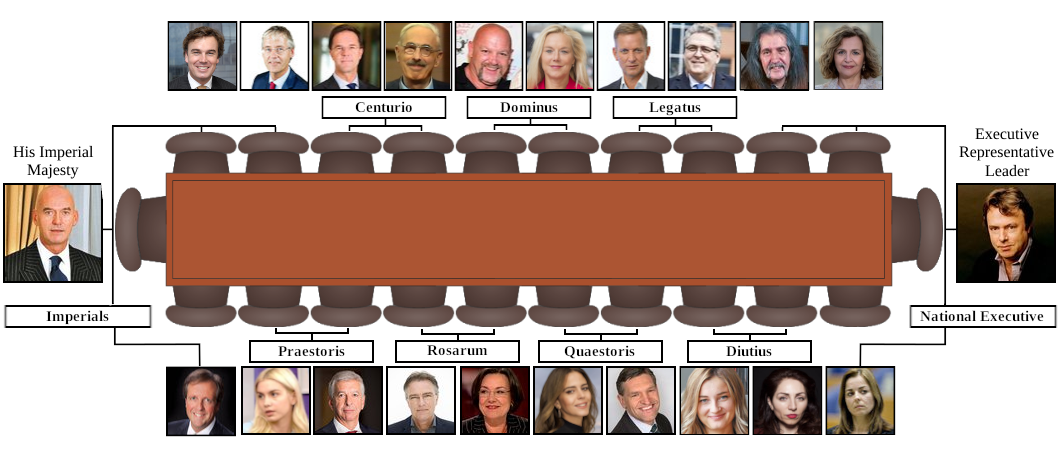
- His Imperial Majesty and His Delegates
- Emperor Artabanos
- Vicarius Wilfred Cocx, ind.
- European Councillor Nicholas Benfield, ind.
- James Cocx, ind. (also Imperial Defence Officer)
- For Terra Centurio
- Basil Lawson, CCU
- Henman Vern, CCU
- For Terra Domini
- Matthew Birch, ILA
- Alaina Kaach, ILA
- For Terra Legati
- Simon Lane, CCU
- Jeffrey Speller, UGF
- For the National Executive
- Lord Christopher Strathclyde, ind.*
- Karen Smith, ind.
- Boris Mancov, ind.**
- Sarah Gladwell, ind.
- For Terra Quaestoris
- Edmund Everet, ILA
- Simge Galanth, Emperor's Finest***
- For Terra Rosarum
- Edith Oxley, ILA
- Ralph Jaevons, CCU
- For Terra Praestoris
- Charles Honeybourne, CPP
- Hetty Tilki, Emperor's Finest
- For Terra Diutius
- Dilkes Ayla, Emperor's Finest
- Nazil Schout, Emperor's Finest
*The Executive Representative Leader (ERL) acts as most imporant Councillor on behalf of the Executive. They are usually occupied with Council business as a full-time job, although they may combine their Councillorship with other duties.
**Boris Mancov IC retained his seat after his dismissal as Imperial Defence Officer in 2022. His subsequent appointment as Commissioner for Drone Warfare was considered grounds enough to keep him on the National Imperial Council, though he is not part of the National Executive. The current Imperial Defence Officer, James Cocx IC, was already a member of the NIC before his appointment to executive office and retained his seat.
***Simge Galanth IC was elected to her Terra Quaestoris seat and subsequently appointed Imperial Consul. She sits on the NIC in a provincial rather than executive capacity.
- Inimician Liberal Appeal: The ILA is a liberal-progressive party supportive of increased devolution of powers from Parliament to the Emperor and local government. Keen on European co-operation, the party ensured EU elections have to be decided by national referendum.
-
Imperial Inimician Government Agencies
(Note: this list is non-exhaustive as of 21st May 2021)
The following organisations, departmental and non-departmental, assist the Imperial Government in the exercise of its duties.
Imperial Bank

CEO: Claes Knot
Under Jurisdiction of: Chancellor of the TreasuryThe Imperial Bank is the central bank of Inimicus. TIB issues the Inimician Guilder, regulates monetary and currency policy, and advises the Imperial Government on budgetary issues. TIB further regulates the substantial Inimician banking industry, setting legal and financial standards national and international banks must meet to trade in the Empire, and potentially offering financial assistance to institutions in need.
Inimician Aeronautical Development Association

Chair: Imperial Consul Simge Galanth IC
Under Jurisdiction of: Imperial ConsulateThe Inimician Aeronautical Development Association is responsible for the Inimician civilian space programme, as well as aeronautics and space research. IADA further works closely with the Imperial Armed Forces to develop strategies, material, and tactics, to advance the Empire's military capability. IADA further contributes heavily to Inimicus's scientific output by investing in research funding into outer space, astrophysics, and space observation topics. IADA was largely responsible for the successful testing of the Croesos Nuclear Missile in the exosphere in 2016, and has worked closely with nuclear development agencies in the Empire to develop Inimicus's nuclear capabilities.
Imperial Border Force

Commander-in-Chief: Imperial Defence Officer James Cocx
Under Jurisdiction of: Imperial Defence OfficeThe Imperial Border Force is Inimicus's national border security agency. The IBF's main aims are to fight against unauthorised travel or trade across the Empire's borders, to limit illegal immigration, combat transnational crime, and prevent wanted criminals from travelling. The IBF also carries out duties following from international sanctions, when vehicles, nationals, or vessels from a specific nation require additional control. The IBF operates on land, sea, and in the air, and boasts an impressive arsenal of vehicles, patrol vessels, and armaments. The IBF is indirectly managed through the Imperial Defence Office, though it is not part of the Imperial Armed Forces.
Imperial Guard

Officer Commanding: Field Marshal Eleonore Budalmi
Under Jurisdiction of: His Imperial Majesty Emperor ArtabanosThe Imperial Guard is the Empire's most senior, elite military unit, dedicated to the protection of His Imperial Majesty the Emperor. The Imperial Guard's duties evolved over time to include additional tasks, such as combat roles, national law enforcement, and investigative duties (see specifically the Imperial Guard Investigation Unit below). Imperial Guardsmen keep watch over the Imperial Palace in Telum, as well as offices and buildings owned or managed by any member of the Imperial Executive and the Emperor. Additionally, local law enforcement departments and military units often request support from the Imperial Guard, and Imperial Guard officers regularly represent the Empire abroad at international military and intelligence conferences.
The Imperial Guard is formally commanded by the Emperor Himself, but day-to-day commanding functions are passed to an Officer Commanding. The Imperial Guard has enacted considerable influence on Inimicus's government and people since the institution of the Empire, with Guard uniforms becoming a familiar sight for most Inimician citizens.
Imperial Guard Investigation Unit

Commander: Albert Rosenfield
Under Jurisdiction of: His Imperial Majesty Emperor ArtabanosThis specialised branch of the Imperial Guard assumes domestic intelligence and security service functions Empire-wide. A leading Inimician, counterintelligence, and criminal investigative organization, the IGIU has jurisdiction over the whole Empire and its territories. IGIU agents investigate national crime, facilitate the prosecution of major criminals, combat major white-collar and institutional crime, as well as transnational criminal enterprises. The IGIU has been described as functioning as "the Emperor's eyes and ears", and has major field offices in every Inimician province, as well as minor offices in virtually every major Inimician city. As a branch of the Imperial Guard, the IGIU handles all intelligence functions, including information sharing policies and intelligence analysis for national and international security and law enforcement purposes.
Imperial Guard Anti-Terror Command

Commander: Gen. Miranda Bolle
Under Jurisdiction of: His Imperial Majesty Emperor ArtabanosWorking closely with the Imperial Guard and IGIU, the IGATC is Inimicus's primary counter-terrorism agency. The IGATC is responsible for protecting the Empire from weapons of mass destruction, acts of terrorism, and foreign intelligence operations and espionage. The IGATC accomplishes its mission by investigating national security threats, providing information and analysis to other law enforcement agencies, and developing capabilities to keep the Empire secure. IGATC employs counterterrorism field operations organized into squads, the number of which varies according to the amount and diversity of activity in the local field office's jurisdiction. IGATC is also highly active in the world of cyberwarfare, protects the Empire against foreign intelligence operations and espionage. It accomplishes its mission of hunting spies and preventing espionage through the use of investigation and interaction with local law enforcement and other members of the Imperial intelligence community.
IGATC is housed in a central Headquarters in Telum, from where it directs cyber strategies and operational commands. The exact number of smaller IGATC branches is unknown.
-
Geography and Topography of Inimicus
The Empire of Inimicus occupies a plot of land in the southeast of the European Union, to the west of Dromund Kaas and the northwest of Angleter. The full map of Inimicus, including province boundaries and city limits, is as follows (click the image for a larger version):
Inimicus's geography ranges from mountain peaks in the very central south and northeast of the country, roughly corresponding to the territories of Terra Dominus and Terra Quaestoris, respectively, to flat plains in the central and western areas. The country is naturally divided by the presence of large rivers, and settlements naturally grew on the riverbanks throughout the development of the country.
Inimicus is administratively divided into seven provinces and a capital district. Inimicus is structured federally, with the Provincial Assemblies and Dukes responsible for much of the day-to-day governing of their province, including in areas such as infrastructure and transport, taxation, and education (though educational standards are set nationally and the national government is responsible for ensuring the quality and quantity of education across the country). Furthermore, provinces are mandated to provide a number of provincial military regiments to the Inimician Armed Forces, and are responsible for maintaining a degree of law and order in their territory. The Telum Capital district has its own assembly, but no Duke, and its duties do not include delivering military units.
The government of each province consists of three major parts:
- The Provincial Assembly, a type of provincial parliament elected on a two-yearly basis. The number of members is set at 100. Being a member is a part-time job. The main task of Provincial Assemblies is to check the work of the Provincial executive, consisting of the other two provincial governmental bodies.
- Provincial College, a type of provincial cabinet elected from among the members of the Provincial Assemblies and charged with some executive tasks. Each province has between 3 and 7 College members, each having their own task. The task of the Provincial Colleges is the overall management of the province in accordance with the Assembly's wishes.
- The Duke or Duchess (often called the Emperor's Commissioner), a single person who is appointed by the Emperor and presides over the Colleges as well as over the Assemblies. The commissioner is appointed for one year, after which period re-appointment is possible, but not common.
The provinces of Inimicus have 7 core tasks:
- The issuing of licences, including driving licences, partnership contracts, and business ownership licences;
- The creation, administration, and funding of municipal governments;
- The maintenance of Territorial law enforcement and military units, as well as of Territorial judicial institutions;
- The provision of primary and secondary education;
- Regional accessibility and infrastructure, as well as further economic development;
- Promoting the coherence, effectiveness, and quality, of Territorial and municipal administrations;
- Planning, spatial development, and management of the environment and any bodies of water and waterways located within the boundaries of the Territory.
An overview of the Inimician provinces is given below.
Terra Rosarum
- Full name: The Imperial Dominion of Terra Rosarum
- Capital city: Portus Inimici
- Motto: Da Mihi Sis Cerevisiam Dilutam
Terra Rosarum is the most populated and largest province of Inimicus. It was founded after the great western expedition of 1578, during which a large number of Inimician settlers travelled westwards to find a new home. Rosarum's capital city is Portus Inimici, one of the largest cities in Inimicus. The remainder of Rosarian population is either urbanised, or lives in the country as agricultural workers. The geography of Rosarum is remarkable: the province is dominated by the three rivers flowing through the province, and the landscape, consequently, has the lowest elevation levels in the country. The highest point of Terra Rosarum is 25.2 metres (756 feet) above sea level. Being the most populated and largest province, Rosarum holds much weight in Inimician decision-making. Rosarum's Provincial Assembly is laid out as follows:
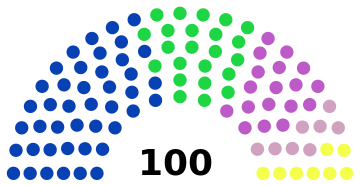
- Inimician Liberal Appeal: 43 deputies
- United Green Front: 23
- Economics First in Rosarum: 18
- Centre-Conservative Union: 8
- Central Progressive Party: 8
Governing coalition: ILA + UGF (66 deputies, majority of 16)
The Duke (Emperor's Commissioner) of Terra Rosarum is Sven Kockelmann (ILA).
Terra Legati

- Full name: The Imperial Dominion of Terra Legati
- Capital city: Patricio
- Motto: Mellita, domi adsum
Terra Legati is the eastmost province of Inimicus. It is situated to the east of Telum, south of Terra Dominus, and northeast of Terra Quaestoris. It is Inimicus's second most populated and second largest province. From the 15th century onwards, the area was an integral part of the Kingdom of Inimicus. During this period Dominus and Legatus were both incorporated. Legatus was the last Inimician province to be incorporated completely through military means: the Inimicians suffered heavy losses when the Legatians besieged Telum, but managed to overcome the assailants. The King then gathered what force remained to him and marched for the three main Legatian cities, occupying them without much ado.
Legatus is one of Inimicus's more hilly provinces. Fluvial erosion has carved out ditches and crevasses, which form a distinctive part of the Province. The hilly terrain has also been the antecedent to the construction of many great Inimician architectural sites, such as the Emperor Hugh Railway Bridge and the Imperial State Tunnel. On the other hand, the eastern Inimician-Kaasian border is completely locked off, and a 20-mile militarised zone has been established along this border to ensure the Dromund Kaas war, which has been ongoing for a long time, does not cross into Inimicus. The Provincial Assembly of Terra Legati is laid out as follows:

- Centre-Conservative Union: 32 deputies
- Legatus Greens: 31
- Inimician Liberal Appeal: 29
- Central Progressive Party: 8
Governing coalition: CCU+ILA (61 deputies, majority of 11)
The Duchess (Emperor's Commissioner) of Terra Legatus is Peter Paul.
Terra Centurio

- Full name: The Imperial Dominion of Terra Centurio
- Capital city: Postquam
- Motto: Fortitude And Leadership
Terra Centurio is the oldest Inimician province, established in the early 15th century after the inhabitants of Telum and the neighbouring city of Lacerta invaded the territory north of their cities, which was then inhabited by an industrious trading people led by a Duchess. Being the first Terra to be incorporated in Inimicus, Centurio has also ensured all other heads of provinces are called Dukes. Terra Centurio's geography is marked by fairly flat surfaces with occasional hills, particularly to the east and northeast. The Provincial Assembly of Terra Centurio is laid out as follows:
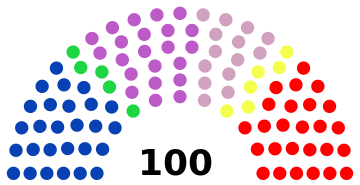
- Inimician Liberal Appeal: 27 deputies
- Centurian National Front: 26
- Centre-Conservative Union: 22
- Party of Centurian Pride: 14
- Central Progressive Party: 6
- United Green Front: 5
Governing coalition: ILA+CNF (53 deputies, majority of 3)
The Duke (Emperor's Commissioner) of Terra Centurio is Anne Colbourn (independent).
Terra Quaestoris
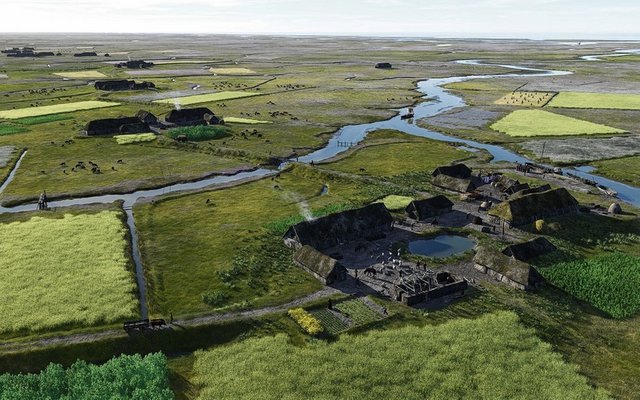
• Full name: The Imperial Dominion of Terra Quaestoris
• Capital city: Lacerta
• Motto: Veni, Vidi, DormiviTerra Quaestoris is the most artificial Terra of Inimicus, with 41% of its land formerly under water. Quaestoris became a Terra after a southern expedition from Telum in the 15th century. The Teluminans found the land to be extremely wet and swampy, but saw the potential for agriculture. In the late 14th century, they had already drained a lake to the east of Telum to accommodate the city's growth, and they adapted the same technology to the newly-prospected land. It took many years and the lives of two monarchs to complete the drainage, but on December 18th 1501 Terra Quaestoris was officially 'finished'. Lacerta, the second city of the Empire, was made the new provincial capital. Currently, Quaestoris is a cattle-focused terra, with much cattle farming and other agricultural industry taking place. This makes the Terra the poorest Inimician province when it comes to GDP per capita. However, since the founding of the Empire, the Terra has gradually been working on the establishment of heavy industry and electricity generation. The mountains in the southwest of the province also benefit the local economy due to winter sports tourism. The Provincial Assembly of Terra Quaestoris is laid out as follows:

- National Socialist Quaestorian Front: 31 deputies
- United Green Front: 29
- Democrats for Quaestoris: 18
- Centre-Conservative Union: 12
- Inimician LiberalAppeal: 5
- Central Progressive Party: 5
Governing coalition: UGF+DemForQua+CPP (52 deputies, majority of 2)
The Duchess (Emperor's Commissioner) of Terra Quaestoris is Ivor Clarke (UGF).
Terra Praestoris
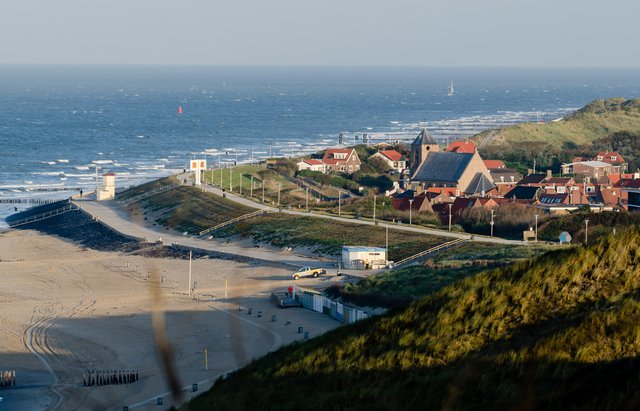
- Full name:The Imperial Dominion of Terra Praestoris
- Capital city: Astro
- Motto: Luctor et Emergo
Terra Praestoris was, like all western Inimician provinces, established after the great expedition of 1578. Praestoris is famous in Inimicus for its many beautiful north western dunes and beaches, which have made the Praestorian tourism industry prosper. Praestoris is often called The Emperor's Terra because current Emperor Artabanos used to be the Duke of this province. Even though Praestoris is small, it is one of the economically stronger Inimician provinces. This is universally accepted to be the case particularly because of the lack of austerity cuts and proper financial policy under the Artabanos Ducal administration. Trade in Terra Praestoris is also booming as the province provides a fast and less busy way of transporting goods into Inimicus and North Diessen when compared with the Inimician mainport, Portus Inimici, even though Praestoris does not have any large cities on the coast. River transport is the way Praestoris has grown for many years. The Provincial Assembly of Terra Praestoris is laid out as follows:

- Support For Artabanos: 55 deputies
- Central Progressive Party: 13
- Inimician Liberal Appeal: 12
- Centre-Conservative Union: 12
- United Green Front: 8
Governing party: Support for Artabanos (55 deputies, majority of 5)
The Duchess (Emperor's Commissioner) of Terra Praestoris is Natia Vonberg (SFA).
Terra Domini

- Full name: The Imperial Dominion of Terra Domini
- Capital city: Dominus
- Motto: Serving Our Dominus
Terra Dominus is the smallest and least densely populated Inimician Province. Large parts of the Terra are covered in high mountains, where bauxite ore mining is the main industry. The province was established when the lands were annexed by internal means in the 15th century, up to which point a Germanic Duchy was situated in the lands. This German ancestry continues into the modern day. Although the smallest province, Dominus has become an integral part of the Inimician Empire since the rise of aluminium. Because of the intensive government mining in the Terra, the northern Dominian mountains are locked off to the public and therefore winter tourism is virtually non-existent in the province. However, the many beautiful natural features in the Dominian lowlands do attract visitors from inside and outside the Empire. Terra Domini oddly uses the former Royal State Coronation Hymn as its provincial anthem because of its close ties to the Royal Household in the days of the Inimician Kingdom. The Provincial Assembly of Terra Domini is laid out as follows:
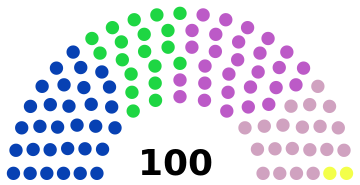
- Inimician Liberal Appeal: 31 deputies
- Centre-Conservative Union: 28
- Unabhängigkeit Für Dominus: 20
- United Green Front: 19
- Central Progressive Party: 2
Governing coalition: ILA+UGF+CPP (52 deputies, majority of 2)
The Duke (Emepror's Commissioner) of Terra Dominus is Judy Speller (UGF).
Terra Diutius

- Full name: The Imperial Dominion of Terra Diutius
- Capital city: Militarae
- Motto: Inimici Quidem Artem Amorium Invenerunt
Terra Diutius the newest administrational unit in Inimicus, established in late July and early August 2020 after the abolition of the Southern Generality, itself a consequence of the disbandment of the previous Terra Imperatoris. The Generality was controlled directly by His Majesty the Emperor and the National Executive, and did not have any representation on the National Imperial Council. This changed in July and August 2020 with a range of constitutional amendments. Geographically speaking, Diutius consists of typical Inimician countryside, with some rolling hills to the east and generally becoming flatter as the rivers progress to the west. Economically, Terra Diutius is considered the second poorest Inimician administration, with only Terra Quaestoris scoring lower on economic development indexes. His Majesty is now using his personal funds to pump money into the Diutian economy, however, and it is expected the lands will flourish as a result. Terra Diutius is also hugely popular with tourists for its notable quaint countryside and architectural sites. The Provincial Assembly of Terra Diutius is laid out as follows:
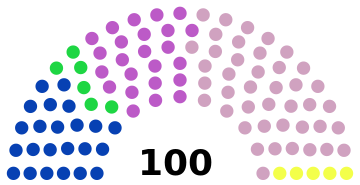
- Inimician Liberal Appeal: 23
- Centre-Conservative Union: 24
- Emperor's Finest: 42
- United Green Front: 6
- Central Progressive Party: 5
Governing coalition: EF+CCU (66 deputies, majority of 16)
The Duke (Emperor's Commissioner) of Terra Diutius is Jacqueline Sargotan (EF).
Districto Teli

- Full name: The Imperial District of Telum
- Capital city: Telum
- Motto: Inimici Quidem Artem Amorium Invenerunt
The Districto Teli (or District of Telum) is the Inimician capital territory. It does not have province status, nor it is a Generality. It is legislated by the Emperor and a Teluminan District Council, consisting of fifty Teluminan Gentlemen and Ladies. This originates in the founding of the Kingdom of Telum in 1351, when a Gentlemen Council was established to rule alongside the absolute monarch. The District was kept in its original state at the founding of the Empire to ensure the federal Inimician model could be kept alive. All important national and Imperial government buildings are located within the District. When it comes to Geography, the District of Telum is famous for its many rivers - and risk of flooding. Flood protection is something the inhabitants of Telum have had to deal with for centuries, and it continues to be a District Council priority spending point. The two rivers running through the district cause many problems, but have also provided the early Teluminans with a fruitful place to live, and they have therefore been the origin of the Inimician nation. The Teluminan District Council is laid out as follows:
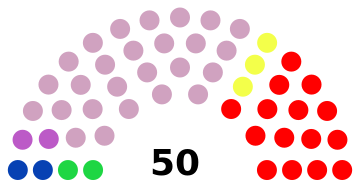
- Imperial Gentlemen and Ladies: 26 representatives
- Teluminan National Socialist Party: 15
- Central Progressive Party: 3
- Inimician Liberal Appeal: 2
- United Green Front: 2
- Centre-Conservative Union: 2
Governing party: Imperial Gentlemen and Ladies (26 representatives, majority of 1)
The Duke of the District of Telum is His Imperial Majesty Emperor Artabanos.
-
Transport in the Empire of Inimicus
Motor Vehicles
The Empire of Inimicus boasts a highly extensive road network. Generally, the Empire's roads are subdivided into Imperial, Provincial, and Municipal roads, with national, territorial, and local administrations responsible for upkeep and construction. The full length of the Empire's road network exceeds 250,000km.
Vehicle Licencing
All vehicles registered in Inimicus are issued with a uniquely identifying licence and registration plate. Registration plates are issued by the Imperial Driver and Vehicle Agency (IDVA, pronounced 'id-vah'), and are issued depending on the address of the registrant. All Inimician registration plates carry a two-letter code identifying the registrant's district of residence. For instance, "TM" refers to the Impreial Capital, Telum. Standard Inimician plates are printed in white font on a black background -- most Inimician plates further feature a blue bar on the left hand side of the plate, carrying an Inimician flag icon and the national identifyer IN (see below).
National-level law enforcent vehicles, such as those belogning to the Imperial Constabulary and Imperial Border Force, are issued with yellow-font plates instead of white, and do not include the national identifyer as these vehicles are not expected to be driven abroad (see below). Similarly, vehicles registered to provincial law enforcement units are printed in yellow, but also include a two-letter provincial identifier. These identifiers are thus:
- Terra Rosarum: RO
- Terra Quaestoris: QS
- Terra Praestoris: PS
- Terra Domini: DM
- Terra Legati: LG
- Terra Centurio: CU
- Terra Diutius: DI


Standard Inimician registration plate (left) and law enforcement plate (right).
Provincial law enforcement and government plate.District codes for major Inimician cities include:
- TM: Telum
- LA: Lacerta
- PA: Patricio
- OT: Orbis Terrarum
- AS: Astro
- PI: Portus Inimici
- MI: Militarae
The Imperial Goverment's vehicles are also registered with yellow-lettered plates. However, Imperial plates also carry a crest identifying the department or authority the vehicle is registered to. Imperial government vehicles are always identified by the letters 'IN' followed by two digits. For example, vehicles registered to the Imperial Household start at IN - 01, showing the Emperor's Hearts crest in the centre:

Non-combat vehicles registered to the Imperial Armed Forces are printed in grey with a national identifying flag printed on the plate. Registration plates are further identified depending on Armed Forces branch (AR: Army; AF: Air Force; NA: Navy), followed by two letters identifying the distrct of registration.

Finally, diplomatic registration plates are printed in white on a black background, including the national identifier bar in blue on the left hand side of the plate. Diplomatic plates are specially identified by the letters 'DC' for 'Diplomatic Corps', and the national identifier code of the country the registered vehicle services (e.g. 'IN' for Inimicus). Diplomatic plates also sport the Imperial Government crest:

Train network
Railways are the second most used form of transport in the Empire of Inimicus, with a network of over 15,000km, around 10,000 of which are fully electrified. Large Inimician cities are connected through the Imperial High Speed Network, stretching nearly 3,000km and linking the Empire to North Diessen, the United Duchies, and beyond, through Eurorail.
Regular Network
90% of Inimcus's regular train services are run by the Imperial Railways, a state-owned company designated by law to provide sufficient and timely train services. The Imperial Railways occupies the majority of the Imperial Government's Transport Division (managed under the office of the Imperial Consuls). Imperial Railways serve most sizeable Inimician towns and cities on a half-hourly basis, and many villages with an hourly service.
Frequent rolling stock includes:

Empire Class 800, mainly used for longer-distance services.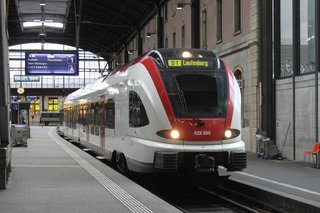
Stadler HUGH, main short-distance stock.
Jameson Class A, main units used on diesel-only lines
Vectron Locomotive
Telum Sprinter commuter trainImperial High Speed Network
The second of Inimicus's rail networks achieves speeds of up to 350 km/h and links the capital, Telum, to Lacerta, Fugit, Domini, Portus Inimici, Astro, Militarae, and several other major population centres. The Imperial High Speed Network further connects to North Diessen's high-speed rail, allowing for transit across the region.
The IHSN is subject to far more rigorous safety standards than the regular Inimician train network. IHSN tracks are fenced to prevent trespassing by animals and people. Level crossings are not permitted and overbridges have sensors to detect objects that fall onto the track. All IHSN junctions are grade-separated, the tracks crossing each other using flyovers or tunnels, eliminating crossings on the level.
Rolling stock of the IHSN includes:

Cocx Class B (left) and A (right)
Patricio Class HST -
HISTORY
List of heads of government/state of the Empire of Inimicus/Republic of Telum/Kingdom of Telum
Available here in PDF format.
Name Term start Term End Term Length Position Title Image Alexander de Barrington 5th April 1801 30th October 1833 (died in offce) 32 years, 5 months, 5 days President of the Republic of Telum 
Theodor Bartkosz 30th October 1833 2nd December 1849 (assassinated) 16 years, 1 month, 2 days President of the Republic of Telum 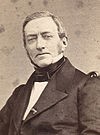
Adam Vicari 2nd December 1849 14th April 1895 (died in office) 45 years, 4 months, 12 days President of the Republic of Telum 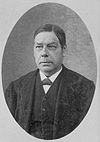
Nathaniel Beylik 15th April 1895 19th June 1919 (died in office) 24 years, 2 months, 4 days President of the Republic of Telum 
Frederick Aeneaum 20th June 1919 16th January 1921 (coup d'etat) 1 year, 6 months, 27 days President of the Republic of Telum 
Conrad of Telum 16th January 1921 1st March 1948 (died in office) 27 years, 1 month, 12 days President of the Republic of Telum 
John Imanol 2nd March 1948 31st December 1971 (died in office) 23 years, 9 months, 29 days President of the Republic of Telum 
Aymed Leykens 1st January 1972 31st December 1986 (coup d'etat) 13 years, 11 months, 30 days President of the Republic of Telum 
Ekrem Couperus 1st January 1987 2nd December 2011 (overthrown) 24 years, 11 months, 1 day President of the Republic of Telum 
THIRD INIMICIAN CIVIL WAR -- REPUBLIC OVERTHROWN
Name Term start Term End Term Length Position Title Image William of Inimicus (Jameson) 30th September 2012 5th May 2013 (assassinated) 7 months, 6 days Emperor of the Inimicians 
Hugh of Inimicus (Doyle) 15th May 2013 12th May 2014 (abdicated) 11 months, 28 days Emperor of the Inimicians 
Artabanos of Inimicus (Gulioglu) 1st June 2014 N/A N/A Emperor of the Inimicians 
